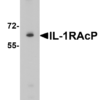Anti-IL-1RacP (CT) Antibody (2131)
$445.00
SKU: 2131
Categories: Antibody Products, Neuroscience and Signal Transduction Antibodies, Products
Overview
Product Name Anti-IL-1RacP (CT) Antibody (2131)
Description Anti-IL-1RAcP (CT) Rabbit Polyclonal Antibody
Target IL-1RacP (CT)
Species Reactivity Human
Applications ELISA,WB,ICC
Host Rabbit
Clonality Polyclonal
Isotype IgG
Immunogen Peptide corresponding to aa 549-569 of human IL-1RAcP. The sequence differs from mouse IL-1RacP by three amino acids.
Properties
Form Liquid
Concentration Lot Specific
Formulation PBS, pH 7.4.
Buffer Formulation Phosphate Buffered Saline
Buffer pH pH 7.4
Format Purified
Purification Purified by peptide immuno-affinity chromatography
Specificity Information
Specificity This antibody recognizes human IL- 1RAcP (66 kD). No cross-reactivity with other members of the IL-1 receptor family.
Target Name Interleukin-1 receptor accessory protein
Target ID IL-1RacP (CT)
Uniprot ID Q9NPH3
Alternative Names IL-1 receptor accessory protein, IL-1RAcP, EC 3.2.2.6, Interleukin-1 receptor 3, IL-1R-3, IL-1R3
Gene Name IL1RAP
Gene ID 3556
Accession Number NP_001161401
Sequence Location [Isoform 1]: Cell membrane; Single-pass type I membrane protein.; [Isoform 2]: Secreted.; [Isoform 3]: Secreted.
Biological Function Coreceptor for IL1RL2 in the IL-36 signaling system (By similarity). Coreceptor with IL1R1 in the IL-1 signaling system. Associates with IL1R1 bound to IL1B to form the high affinity interleukin-1 receptor complex which mediates interleukin-1-dependent activation of NF-kappa-B and other pathways. Signaling involves the recruitment of adapter molecules such as TOLLIP, MYD88, and IRAK1 or IRAK2 via the respective TIR domains of the receptor/coreceptor subunits. Recruits TOLLIP to the signaling complex. Does not bind to interleukin-1 alone; binding of IL1RN to IL1R1, prevents its association with IL1R1 to form a signaling complex. The cellular response is modulated through a non-signaling association with the membrane IL1R2 dUniProtKB:Q61730, PubMed:10799889, PubMed:9371760, PubMed:10653850, PubMed:19836339}.; [Isoform 2]: Associates with secreted ligand-bound IL1R2 and increases the affinity of secreted IL1R2 for IL1B; this complex formation may be the dominant mechanism for neutralization of IL1B by secreted/soluble receptors (PubMed:12530978). Enhances the ability of secreted IL1R1 to inhibit IL-33 signaling (By similarity). {UniProtKB:Q61730, PubMed:12530978}.; [Isoform 4]: Unable to mediate canonical IL-1 signaling (PubMed:19481478). Required for Src phosphorylation by IL1B. May be involved in IL1B-potentiated NMDA-induced calcium influx in neurons (By similarity). {UniProtKB:Q61730, PubMed:19481478}.
Research Areas Neuroscience
Background Cellular responses induced by the pro- inflammatory cytokine IL-1 require two subunits of the IL-1 receptor, IL-1 receptor 1 (IL-1R1) and IL-1 receptor accessory protein (IL-1RacP). IL- 1RacP forms a complex with IL-1R1 in response to IL-1 treatment. IL-1 receptor-associated kinase (IRAK) mediates activation of NF-kappaB inducing kinase (NIK) and NF-kappaB and associates with the IL-1Rcomplex through IL- 1RacP. IL-1 activation of stress- activated protein kinase andof acid sphingomyelinase also requires IL- 1RacP. Like IL-1R1, the IL-1RacP subunit is essential for IL-1 mediated cellular responses. IL-1RacP is expressed in a variety of tissues.
Application Images



Description Western blot analysis of IL-1RAcP expression in K562 cell lysate with IL-1RAcP antibody at 1 ug/ml.

Description Immunocytochemistry of IL-1RAcP in HeLa cells with IL-1RAcP antibody at 5 ug/mL.
Handling
Storage This antibody is stable for at least one (1) year at -20°C. Avoid multiple freeze- thaw cycles.
Dilution Instructions Dilute in PBS or medium which is identical to that used in the assay system.
Application Instructions Immunoblotting: use at 1:500-1:1,000 dilution.
Positive control: Whole cell lysate from HeLa cells.
Positive control: Whole cell lysate from HeLa cells.
References & Data Sheet
Data Sheet  Download PDF Data Sheet
Download PDF Data Sheet
 Download PDF Data Sheet
Download PDF Data Sheet





